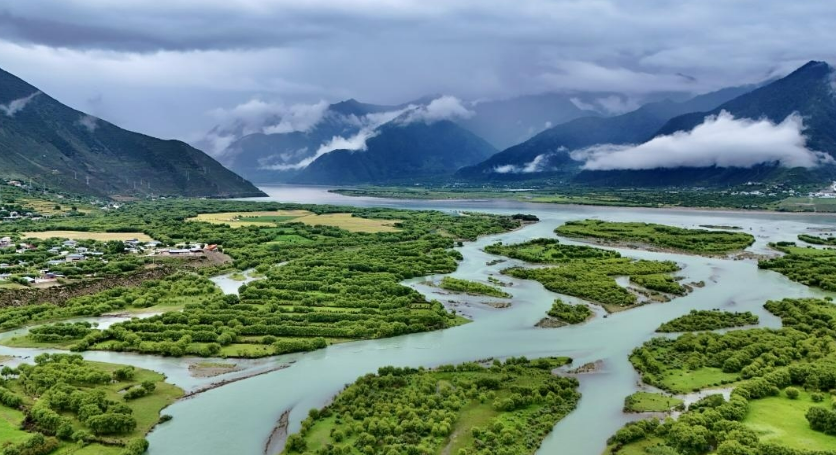China's photovoltaic industry venturing into offshore territories
HAIKOU, Aug. 8 (Xinhua) -- On a vast salt pan in Yinggehai Town, located in Ledong Li Autonomous County of Hainan Province in Southern China, a massive array of 434,000 photovoltaic (PV) panels generates a continuous supply of clean energy.
This is the largest centralized PV base in Hainan. The recently completed facility can generate about 720 million kilowatt-hours of clean energy annually, saving 288,000 tonnes of standard coal, and reducing carbon emissions by 715,000 tonnes each year.
"The salt pan area is very rich in solar energy resources, and the average annual evaporation is twice as much as the rainfall, which has significant PV development value," said Wang Jiaping, project manager from Hainan Holdings Energy Co., Ltd.
Wang also noted the challenges in building a PV power plant on a salt pan. The silt layer reaches 7 to 8 meters, necessitating precision construction management to ensure that each pipe pile error remains within two centimeters. Technicians used satellite positioning and drone measurements, to tackle more than 60 key technologies such as water operations and intelligent inspection.
China's mainland coastline stretches about 18,000 kilometers, offering vast potential for marine PV development. Experts believe that offshore PV has numerous advantages over traditional land PV.
"PV power generation consumes a lot of ground space resources, and the available land for PV development is limited," said Cui Lin, deputy secretary-general of the Special Committee on Offshore Photovoltaic System, China Photovoltaic Industry Association. "Offshore PV, however, offers wider deployment space for larger-scale applications."
Offshore PV modules, positioned close to or partially immersed in seawater, also benefit from enhanced cooling and heat dissipation, improving power generation efficiency, Cui added.
Meanwhile, other coastal areas in China are also embracing offshore PV projects. In east China's Fujian Province, over 30,000 PV panel pipe piles have been installed in the seawater for the region's first offshore PV project. Once completed, it will generate an average of 300 million kilowatt-hours of clean electricity annually, saving 90,200 tonnes of standard coal per year.
Another offshore PV project is currently underway at Lianyungang, east China's Jiangsu Province. The China National Nuclear Corporation's 2 million kW PV demonstration project integrates PV and nuclear power, which can effectively reduce the negative impact on the marine ecosystem and supply more clean energy to neighboring cities.
Off the coast of Haiyang, east China's Shandong Province, the country's first pile-based fixed offshore PV demonstration project is operating smoothly in waters with an average depth of 7 meters. These offshore PV power stations are assembled on land before being transported offshore and installed underwater, requiring higher efficiency to reduce costs and strong, crack-resistant components.
As China expands its renewable energy infrastructure, projects like these are setting new benchmarks for clean energy production. These initiatives, which focus on innovation, efficiency and environmental protection, are crucial steps towards a more sustainable and energy-secure future.
In September 2023, the National Energy Administration proposed supporting pilot offshore PV projects in areas with favorable solar energy resources and construction conditions, such as salt pans.
China also encourages the integration of photovoltaics with other industries. A white paper released last month promoted the co-development of PV projects and marine aquaculture.
In the future, offshore PV can be integrated with offshore wind power, marine ranching, seawater desalination, and offshore hydrogen production, sharing space and facilities to achieve large-scale offshore clean energy development, Cui said.
Despite advances, technological issues persist. Anti-corrosion measures and preventing marine organisms from attaching to equipment are significant challenges, Cui said.
"Moreover, intelligent operation and maintenance after large-scale offshore deployment is a technical bottleneck, as offshore installations cannot be easily dismantled and replaced like on land," he added.
Experts urge enterprises to invest in research and development, promote technological innovation, and enhance the offshore PV industry's competitiveness.
Photos
Related Stories
- 1st phase of Panjiang million-kilowatt photovoltaic base project starts uploading power to grid
- China's major offshore PV project begins construction
- Lebanon International Solar Week 2024 kicks off in Beirut
- PowerChina launches construction of photovoltaic power plant in Algeria
- A glimpse of photovoltaic power project in east China's Zhejiang
- India still needs China's PV products to meet solar power targets: experts
- China's PV industry contributes to global green development
- China's PV industry sees accelerated development, expanded overseas market
- New PV project connected to grid in NW China
- Cerbong photovoltaic power station in Xizang highest altitude in the world
Copyright © 2024 People's Daily Online. All Rights Reserved.









